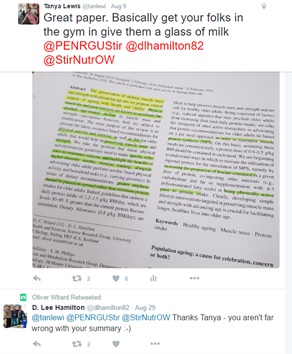Growing older with health and vitality…. What does the research say?
What would you pay to add quality years to your life or perhaps feel younger and reduce the aging process?
This is a common question with a myriad of different answers. If you google ‘preventing aging’ you get pages of skin care advertisements along with bottles of pills but if you check the journals you will find a different answer. A research group from Scotland put together a review summary earlier this year essentially answering this question.
After reading through the paper, I summarised it with a tweet (below) and the authors agreed!

Essentially the paper says; keep lifting something heavy, ‘huff & puff’ and include protein regularly in your diet. The authors make a point that strength training or lifiting weights and higher intensity training (ie more than a walk) is not only safe but receommended in older adults. It really helps to take away the ‘I am too old’ excuse and encourages people of all ages into the gym. Of course your doctor should be consulted in new exercise plans and in an ideal world we would all organically continue to move in such a way. However, as we are not chasing bears, chopping wood or dragging trees a planned exercise schedule helps tick all the boxes.
There is an interesting point about how the ‘use it or lose it’ principal speeds up as we age. Older muscle is more vulnerable to wasting and even short periods of decreased steps and activity can accelerate muscle decline. The paper focuses specifically on behaviour and nutrition to prevent sarcopenia (muscle wasting), a common cause of physical disability and decline but fails to address behaviours relating to preserving brain health.
Alzheimers Australia agree that among other things, physical activity is a top priority in optimising cognition and brain health but also stresses the importance of healthy eating (grains, fruit, vegetables, fish and minimally processed foods) and brain exercise (see these 5 simple steps)
I have also followed with interest over the years the evidence for the ‘blue zones’ (great article here) which follows those populations that live the longest healthiest lives. Typically protein intakes in these groups are not as high as suggested by the researchers but diets are very rich in nutrients and also rely on minimally processed foods. Keeping socially and physically active is also a key ingredient.
Combining all three philosophies, it seems that the key piece of overlapping advice is to keep your body moving and avoid overdoing low nutrient foods. Get your folks into the gym 🙂
-Tanya Lewis
